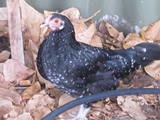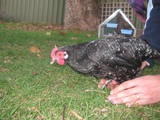Ancona Chickens: A Good Egg Layer
Ancona chickens are closely related to the Leghorn breed. They tend to lay longer into the winter without supplemental light unlike most other breeds.
Ancona Chickens The Facts:
Class: Standard: Mediterranean / Bantam: Single Comb, Clean Legged and Rose Combed, Clean Legged
Size: Standard Male: 6 Ibs. / Standard Female: 4.5 Ibs. / Bantam Male: 26 oz. / Bantam Female: 22 oz.

Comb, Wattles & Earlobes: There are two varieties based on comb.
Single Comb: Bright red, medium size red comb has five distinct points. Male: All five points stand upright. Female: First point stands upright; other four droop to one side.
Rose Comb: Bright red, medium size, red rose sits square in front.
Their wattles are bright red and their earlobes are white. Male: Long, well-rounded wattles and small almond shaped earlobes, close to head. Female: Medium, well-rounded wattles, and oval earlobes close to the head.
Color: They have a yellow beak, though some have black or horn shading at the center. They have reddish brown eyes and their shanks and toes are yellow, though yellow mottled with black is acceptable. The plumage is shiny greenish black with white speckling on the tips of the feathers. These are distributed evenly and frequently across the body.
Place of Origin: Italy
Conservation Status: Threatened
Special Qualities: Lays long into the winter without artificial light.
This breed originated along the Italian coast and made their way to Britain in the mid-nineteenth century and soon thereafter to the United States. Ancona Chickens are closely related to the Leghorns. When they first arrived in the U.S. some even referred to them as "Mottled Leghorns."
Much like the Leghorns, they are excellent layers of large white eggs. The hens are not known to be broody. The breed is considered to be very hardy and the birds are very active. They are excellent foragers as well and could be excellent free- range birds. Their alert activity and their black coloring also make them excellent birds where there are chances of birds of prey, such as hawks and owls. These alert birds can hold their own.
The APA admitted the single comb variety in 1898 and the rose comb variety in 1914.

Custom Search




New! Comments
Have your say about what you just read! Leave me a comment in the box below.